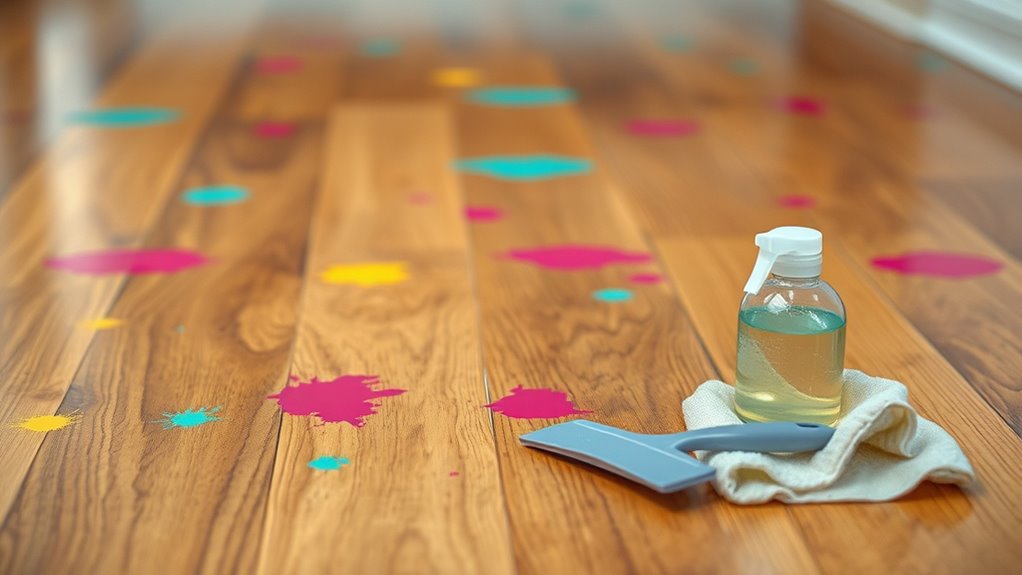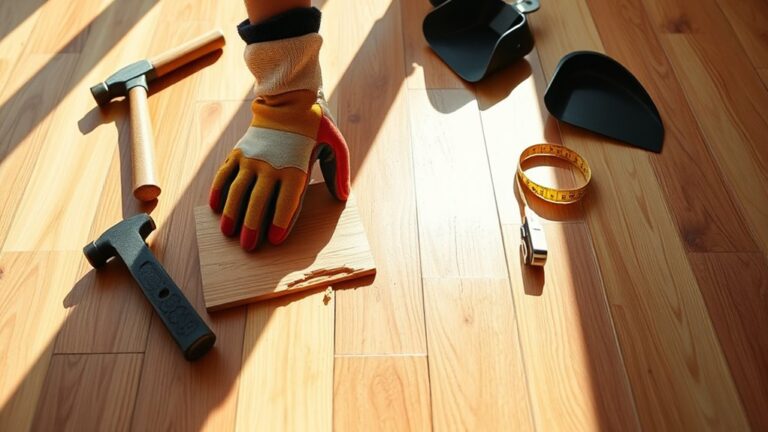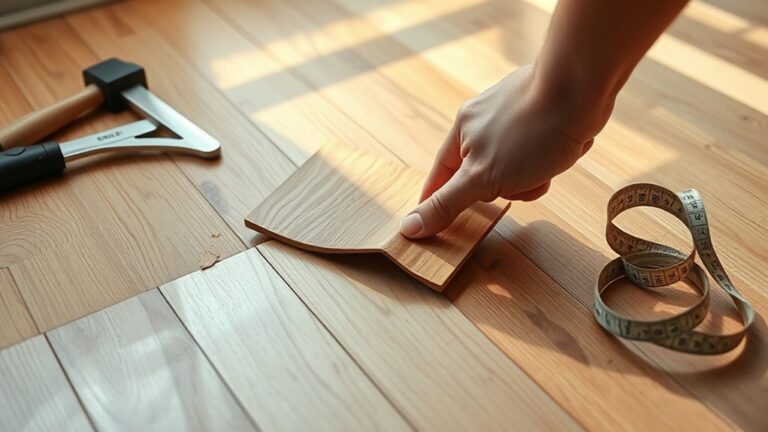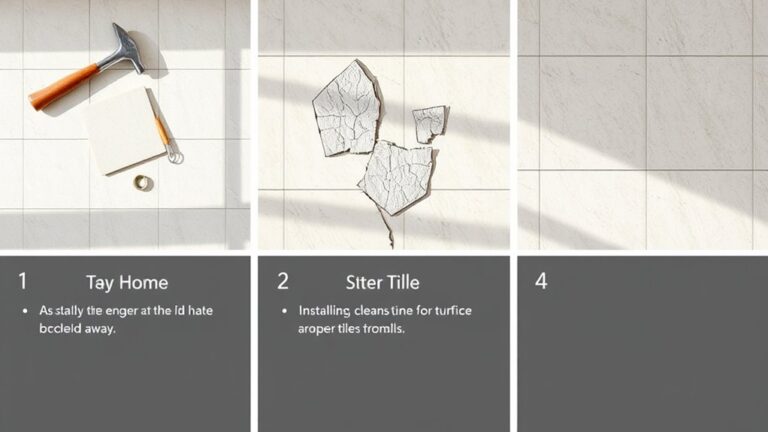To remove dried paint from your hardwood floors without sanding, first identify the paint type—water-based paints soften with warm soapy water or vinegar, while oil-based paints may need rubbing alcohol or a wood-safe commercial remover. Use a plastic scraper gently to lift softened paint, avoiding scratches. Always test removers on a hidden spot first. After removal, clean and polish your floor to restore its finish. Follow these steps carefully, and you’ll uncover even more effective techniques.
Understanding the Types of Paint on Hardwood Floors
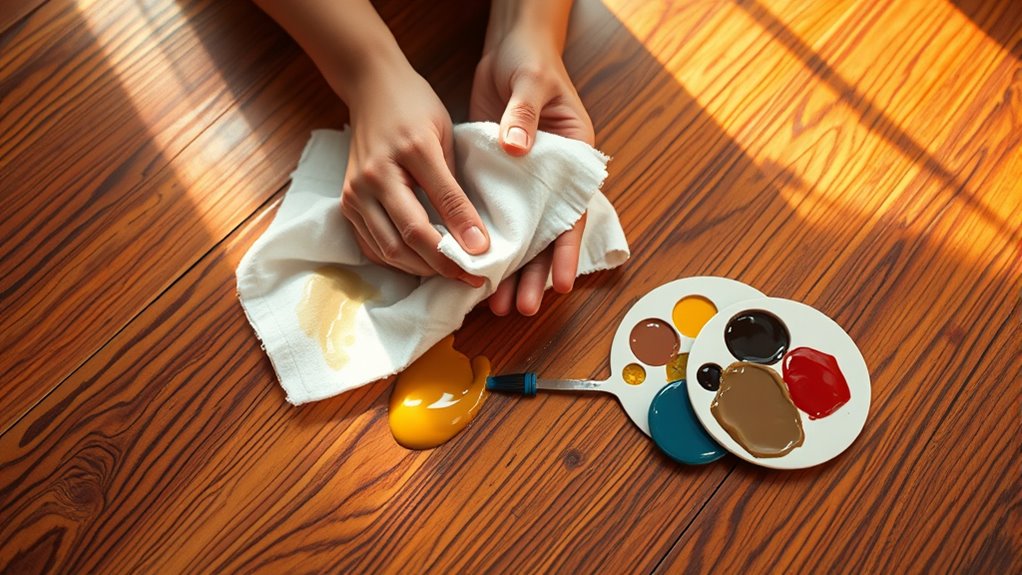
When dealing with dried paint on hardwood floors, the first step is understanding the type of paint you’re facing. Paints generally fall into two categories: oil based paints and water based paints. Oil based paints are durable and adhere strongly to surfaces, making removal more challenging. Water based paints, such as acrylics or latex, tend to be easier to soften and remove due to their water solubility. Identifying the paint type will guide your approach and choice of solvents or cleaning agents. You can usually tell by the paint’s texture, smell, or the cleanup method originally recommended. Knowing whether you’re dealing with oil based paints or water based paints empowers you to take precise, efficient action without unnecessary damage to your hardwood floors.
Tools and Materials Needed for Paint Removal
Successful removal of dried paint from hardwood floors depends largely on having the right tools and materials at hand. Start with a plastic scraper or putty knife to gently lift paint without damaging wood. You’ll also need soft cloths and fine steel wool for delicate abrasion. For effective cleaning solutions, opt for a commercial paint remover specially formulated for hardwood or a homemade mix of warm water and mild dish soap. Avoid harsh chemicals that can strip the finish. Rubber gloves and protective eyewear safeguard you during the process. A spray bottle helps apply solutions evenly, and a bucket for rinsing keeps your workspace tidy. These tools and materials align with proven paint removal techniques, ensuring you maintain your floor’s integrity while reclaiming its natural beauty.
Preparing the Hardwood Floor for Paint Removal
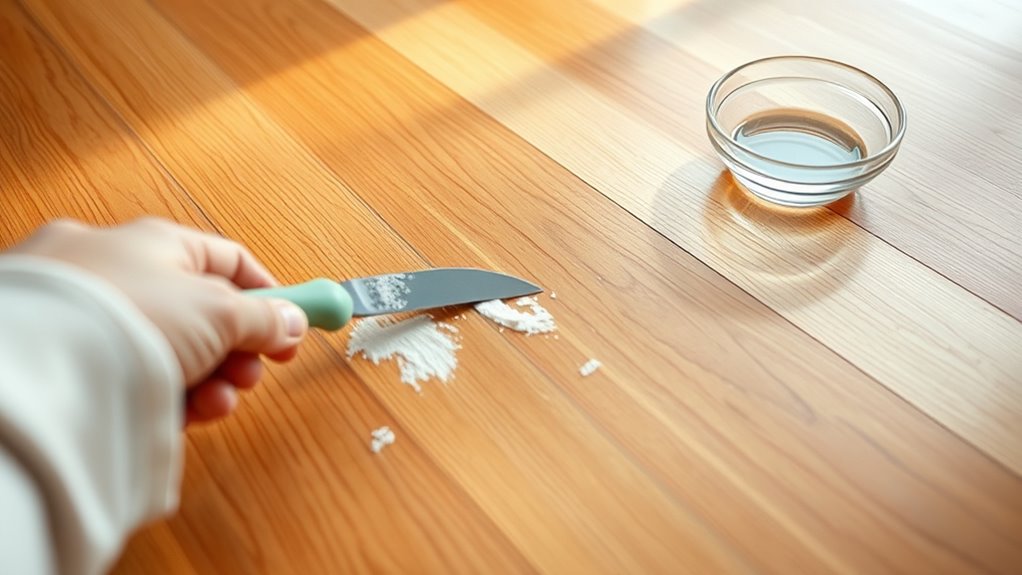
Before you start removing dried paint, make sure to clear the area completely to give yourself ample working space. Gather all the necessary tools outlined earlier so you won’t have to stop midway. Finally, protect adjacent surfaces with drop cloths or painter’s tape to prevent any accidental damage.
Clear the Area
A well-prepared workspace is vital for effectively removing dried paint from hardwood floors. Start by clearing the area completely—move furniture, rugs, and any decorative items to prevent damage and allow unhindered access to the paint spots. This step guarantees you can apply cleaning techniques efficiently without obstruction. Next, protect the surrounding floor with drop cloths or plastic sheeting to catch any paint chips or cleaning residues. Floor protection is essential to maintain the wood’s finish and avoid further damage during the removal process. Removing all obstacles also reduces the risk of accidental spills or smudges spreading to clean areas. Taking these methodical steps sets a controlled environment, giving you the freedom to work precisely and confidently on restoring your hardwood floors.
Gather Necessary Tools
While preparing to remove dried paint from your hardwood floors, gathering the right tools is essential to guarantee efficiency and prevent damage. Your tool selection should align with the paint types involved—latex or oil-based—to ascertain effective removal without compromising the wood’s finish. Having the correct implements allows you to work methodically, maintaining control and freedom throughout the process.
| Tool | Purpose | Suitable Paint Types |
|---|---|---|
| Plastic Scraper | Gently lifts paint without scratching | Latex & Oil-based |
| Putty Knife | Removes stubborn paint patches | Oil-based & Latex |
| Soft Cloth | Applies solvents and cleans residue | Latex & Oil-based |
| Mild Solvent | Loosens dried paint | Oil-based (test on spot) |
| Warm Soapy Water | Cleans surface post-removal | All paint types |
Protect Adjacent Surfaces
Since paint removal can be messy and may damage nearby surfaces, you’ll need to carefully protect any adjacent areas before you begin. Proper preparation guarantees you maintain the integrity of your space while working efficiently. Focus on:
- Protecting baseboards by applying painter’s tape along edges to prevent accidental scratches or paint smudges.
- Covering furniture with drop cloths or plastic sheeting to shield them from dust, paint chips, or cleaning chemicals.
- Laying down protective floor coverings around the work area to catch any drips or debris during removal.
Using Warm Soapy Water to Soften Dried Paint
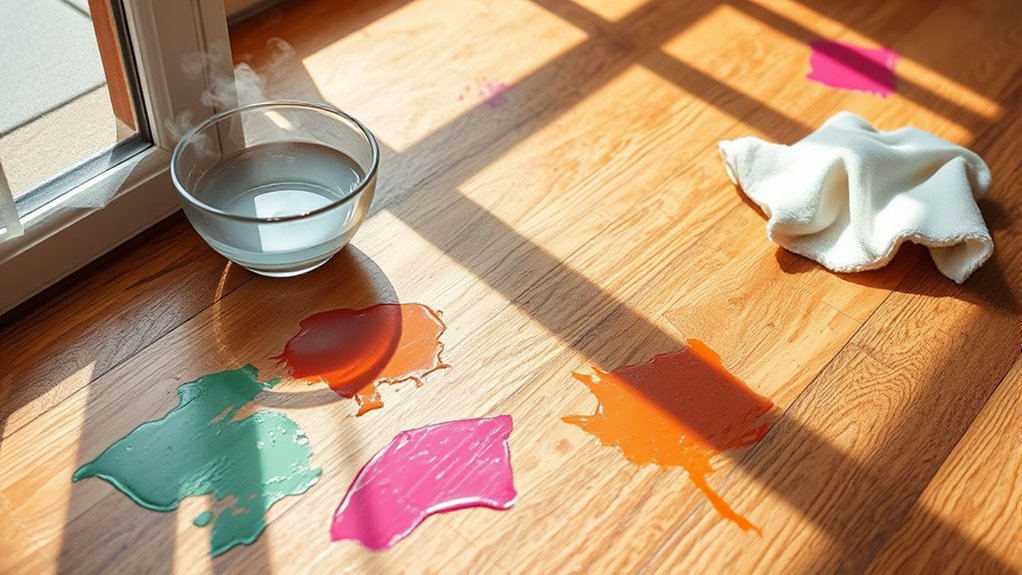
Start by mixing a mild detergent with warm water to create an effective soapy solution. Apply this gently to the dried paint, allowing it to soften without damaging the wood. Then, use a soft cloth or sponge to carefully scrub the area, focusing on loosening the paint without scratching the hardwood.
Preparing Warm Soapy Solution
How exactly does warm soapy water help in loosening dried paint on hardwood floors? Warm water combined with soap creates a gentle cleaning solution that penetrates and softens the paint’s bond without damaging the wood. This method gives you control, avoiding harsh chemicals or sanding.
To prepare an effective warm soapy solution:
- Use warm water (not hot) to prevent warping or damage to the hardwood.
- Add a few drops of a mild dish soap to create a balanced cleaning solution.
- Mix thoroughly until suds form, ensuring even distribution for ideal paint softening.
This simple, safe solution empowers you to tackle dried paint with confidence while preserving your floor’s integrity.
Applying Solution to Paint
Although dried paint can be stubborn, applying the warm soapy solution carefully will help soften it for easier removal. Start by gently pouring the diluted solution onto the paint spots, guaranteeing you don’t soak the hardwood excessively. The key is to use diluting solutions that weaken the paint adhesion without damaging the wood’s finish. Allow the warm soapy water to penetrate the paint for several minutes; this softens the dried layers, loosening their grip on the floor. Avoid rushing this step, as patience guarantees the paint lifts more easily. By methodically applying the solution, you maintain control over the process, preserving your hardwood’s integrity while preparing the paint for removal. This approach maximizes effectiveness without sacrificing the freedom to protect your flooring.
Gentle Scrubbing Techniques
One effective method to lift dried paint without harming your hardwood floors is gentle scrubbing with warm soapy water. This approach softens the paint, making it easier to remove without sanding. Focus on gentle techniques to preserve your floor’s finish while loosening the paint. Follow these scrubbing methods for best results:
- Use a soft cloth or sponge dampened with warm, soapy water to avoid scratching.
- Apply light pressure in circular motions to gradually break down the paint.
- Rinse the cloth frequently to prevent reapplying loosened paint.
Applying Vinegar as a Natural Paint Remover
A practical and eco-friendly solution for removing dried paint from hardwood floors is applying vinegar. Vinegar properties, such as its mild acidity, help break down paint without damaging the wood’s finish. To use this natural alternative, first dampen a clean cloth with white vinegar and gently press it onto the paint spot. Allow it to sit for 10 to 15 minutes, letting the vinegar soften the dried paint. Then, use a plastic scraper or a soft brush to lift the loosened paint carefully. Repeat the process if necessary, but avoid soaking the floor to prevent moisture damage. Vinegar offers a safe, natural alternative to harsh chemicals, giving you control and freedom to restore your hardwood floors effectively.
Using Rubbing Alcohol to Break Down Paint Residue
You’ll want to select isopropyl rubbing alcohol with at least 70% concentration for effective paint breakdown. Apply it sparingly using a soft cloth, gently rubbing the paint residue to avoid damaging the wood. This method loosens dried paint without harsh chemicals, making cleanup easier.
Choosing the Right Alcohol
Although several types of alcohol can help dissolve dried paint, rubbing alcohol is often your best choice due to its balance of effectiveness and safety for hardwood floors. When selecting the right alcohol, you’ll want to take into account the following:
- Isopropyl alcohol: Commonly available and effective at breaking down paint without damaging wood finishes.
- Ethyl alcohol: Often found in higher concentrations, it’s a stronger solvent but may be harsher on delicate surfaces.
- Purity and concentration: Choose rubbing alcohol with 70-90% concentration for ideal paint removal without risking floor damage.
Application Techniques for Paint Removal
Start by applying rubbing alcohol directly onto the dried paint using a clean cloth or cotton ball. This effective solvent begins breaking down the paint’s adhesion without harming your hardwood floor. Let it sit for a few minutes to soften the residue. Next, gently rub the area in a circular motion, using light pressure to avoid damaging the wood. If the paint resists, reapply the rubbing alcohol and wait a bit longer. These paint removal techniques rely on patience and precision—forceful scraping can harm your floor’s finish. Once the paint loosens, wipe away the softened residue with a clean cloth. Finally, clean the area with a damp cloth to remove any solvent traces, ensuring your hardwood remains protected while reclaiming your floor’s natural beauty.
Employing a Plastic Scraper to Lift Paint Gently
When dealing with dried paint on hardwood floors, using a plastic scraper can be an effective way to lift the paint without damaging the wood. To employ plastic scraper techniques properly, start by choosing a scraper with a thin, flexible edge to avoid scratching. Use gentle lifting methods by working slowly at a low angle, applying minimal pressure to loosen the paint. Here are key tips:
- Hold the scraper nearly parallel to the floor for controlled lifting
- Push the paint gently rather than forcefully prying it off
- Clean the scraper frequently to prevent paint buildup
This method preserves your floor’s finish while removing paint. By mastering these plastic scraper techniques, you maintain freedom from harsh sanding and keep your hardwood intact.
Utilizing Commercial Paint Removers Safe for Wood
Several commercial paint removers are specifically formulated to be safe for hardwood floors, allowing you to effectively remove dried paint without harming the wood or its finish. When choosing a commercial product, prioritize those with clear wood safety assurances and non-toxic ingredients. Always test the remover on a small, inconspicuous area first. Apply the remover as directed, let it sit briefly, then gently wipe away softened paint with a cloth or scraper.
| Product Name | Wood Safety Features | Application Tips |
|---|---|---|
| Citristrip Paint Remover | Biodegradable, non-toxic | Apply thin layer, wait 15 mins |
| EcoFast Gel | Water-based, non-flammable | Use soft cloth for removal |
| Dumond Smart Strip | No harsh solvents, biodegradable | Multiple thin coats work best |
Using these commercial products guarantees paint removal while preserving your floor’s integrity.
Cleaning and Restoring the Floor After Paint Removal
Although removing dried paint is an essential step, you’ll need to thoroughly clean and restore your hardwood floor to guarantee its surface returns to its original condition. Start by wiping the area with a damp cloth and a gentle wood cleaner to remove any residue. Then, focus on restoring shine and ensuring durability. Here are key floor maintenance tips to follow:
- Use a microfiber mop with a suitable hardwood floor polish to enhance luster.
- Avoid excess water; moisture can damage wood, so dry the floor promptly.
- Apply a protective wax or finish to seal the surface and prevent future damage.
Preventive Tips to Avoid Paint Spills on Hardwood Floors
Since preventing paint spills is far easier than cleaning them up, taking proactive measures is essential to protect your hardwood floors. Start by laying down high-quality drop cloths or plastic sheeting to create a reliable barrier against accidental drips. Use painter’s tape along the edges to secure coverings and prevent paint from seeping underneath. When working with paint, keep brushes and rollers over the covered area only, and avoid overloading them to minimize splatters. Store paint cans securely with lids tightly sealed, away from foot traffic. Wearing slip-resistant shoes helps you maintain steady footing, reducing the risk of spills. These preventive measures are straightforward but vital for effective paint protection, helping you maintain your floors’ pristine condition and preserving your freedom from extensive cleanup later.

